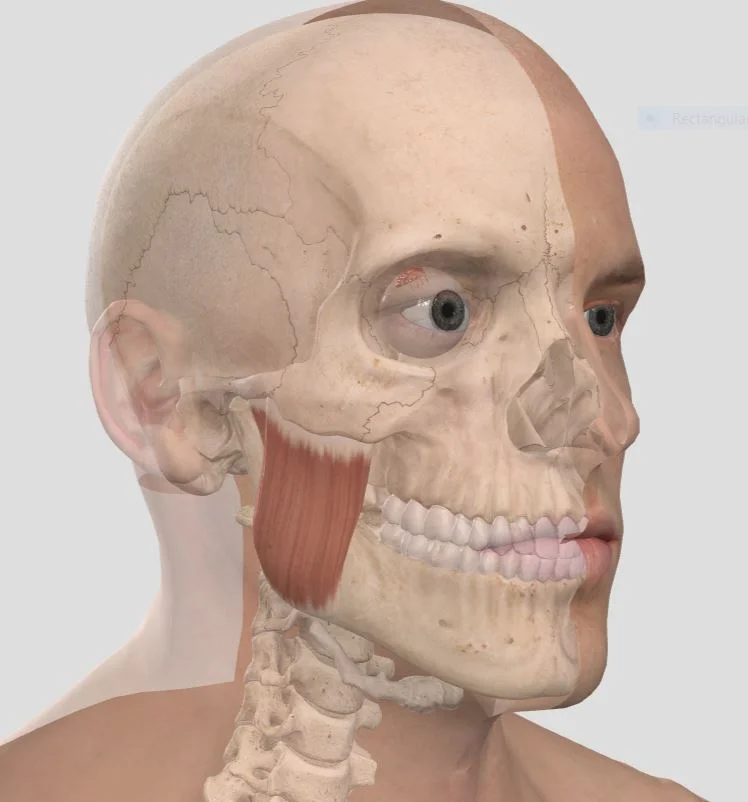When it comes to taking care of your jaw, there are a lot of things you can do at home to complement what we do during the physiotherapy treatment. I will let you know which of these things are best suited for you, regard this as a resource and reminder.
What is TMJ, anyways?
TMJ stands for temporo-mandibular joint, that is the joint between your head (bone of the temple) and your jaw (mandible). In fact everyone has two of them, one on either side. If we would be to look at one of them we would see that the top part of the joint is more like a socket and the end of the mandible looks like a fist that fits in the socket. There is a disc made out of cartilage between the fist and the socket that helps to fill in the space so that the shape of the mandible fits the shape of the socket better, especially during movements of the joint.
When things don’t work as they should, we call it TMD, short for temporo-mandibular disorder. This does not mean anything specific, it’s more of a broad term, but with proper thorough assessment we can identify the main pattern of the dysfunction. That is, whether it’s more of a muscle problem (tightness, uncoordination, imbalance, weakness) or more of a joint problem (inflammation, disc not functioning well, wear and tear). Then, obviously, we do something about it. Read on to find out more.
Massage techniques
Masseter, this is the muscle on the side of your jaw that runs from the cheek bone down to the angle of the jaw. Often it is tight and sore from excessive clenching either during the day or night.
To massage it place your thumb on the opposite side of the mouth between the teeth and the cheek with the thumb pad facing the cheek. Move the thumb back until the tip of your thumb reaches the muscle. To check that you are on the right spot clench your teeth together and you should feel the muscle bulging against your fingers.
Then release the clenching and let your upper and lower teeth separate slightly. Slowly press on the muscle, scanning for tender areas from the cheek bone to the corner of the jaw. You can spend one minute per side but make sure you are not causing pain, slight discomfort is okay.
Temporalis muscle is located in the temple area and runs back above the ears as well, so it is easy to access, just rub your temples slowly and gently and you can get it to relax.
To massage this muscle from the inside of the mouth place your index finger, pad facing in, into the opposite side of your mouth between the upper teeth and the cheek. Keeping the finger straight, slide the pad along the upper teeth until you run into the bony part of your jaw, here you can slightly aim the tip of the finger upward and just hold gentle pressure on the spot. This will be particularly tender on most people so go slow. Hold pressure for about 30 second on either side.
Pterygoid muscles are the lesser known muscles of the jaw as they cannot be touched from the outside and are located very deep under the base of your skull.
Massaging this muscle group might look similar to Temporalis, as you place the index finger in the opposite side of the mouth, except you will keep the finger slightly bent and run the pad along the upper gums. This will allow you to curl back and around your last molars. There you will run into a dead-end where you could not move further back or up. That’s the spot where you want to hold gentle pressure for about 30 seconds per side.
Changing habits
We all have our special way of dealing with stressful situations around us and many times we are not even aware of what we do. Biting the lips, sucking the cheeks in or pushing the tongue into the teeth (not to mention clenching and grinding teeth together) are all ways we create excessive tension as a response to our environment. You can have a look at this checklist and see how many habits related to improper use of the jaw you have. Bring it with you at our next appointment and we can discuss what can be done.
Here is what you can do to start changing those habits:
pay attention, observe, notice, catch yourself doing your habitual response
take a slow breath noticing if there is anything around you that you are responding to, is there a good reason for you prepare to fight or run?
with lips together, slightly separate your teeth, making sure the tip of the tongue is resting behind the upper teeth
“lips together, teeth apart”
Another great habit-changing tip is to keep your jaw in the relaxed position (lips together, teeth apart, tongue up) and then wiggle your jaw side to side.
“tongue up and wiggle”
Use these tips often through the day, aim for every 15 minutes while you are awake. I know that sounds like a lot to do but better to aim high and land a bit ahead. You can use various things as reminders: a gentle alarm on your screen or phone, receiving a text, email or phone call, being stopped at a red light while driving or noticing a certain brand of car in traffic. At home you can remind yourself to wiggle every time you go through a door way, go up or down stairs. Don’t forget about your active play time, very often we tend to clench during a workout so wiggle away!
Don’t forget to be patient with this process, it takes time to change a habit!
